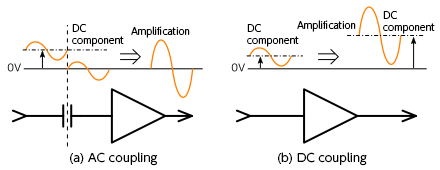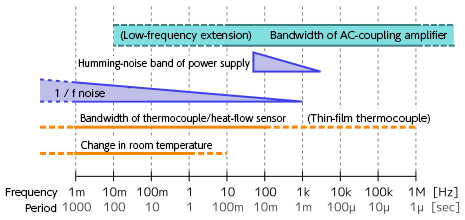Posted 2019/7/19
Input coupling of the preamplifier is either AC coupling or DC coupling (Figure 1).
AC coupling is a method of inputting a signal into the preamplifier after the DC (low-frequency) component has been removed.
Figure 1

Below operating frequency of 1 kHz, low-frequency noise called 1/f noise is emitted by semiconductors. Also, in the range of 50 Hz to 3 kHz, a humming noise due to a mixture of the commercial power supply frequency and its higher harmonics occurs. As a result, in the case of AC coupling aiming at low noise, signal components from 1 kHz to 10 kHz or lower are often removed (Figure 2).
Moreover, the DC component of the input signal can be eliminated, so AC coupling also has the merit that it is easy to amplify a very small signal with high gain. Although AC coupling down to 1 mHz may be realized while DC component is removed, generally, about 10 Hz is the lower limit of AC coupling.
In the case of DC coupling, however, both DC (low-frequency) components and AC components are amplified together. It is thus necessary to take care to amplify them at high gain so that the output of the amplifier does not exceed the maximum output voltage.
So which coupling method is best?
To answer that question, for example, consider a preamplifier connected to a thermocouple for measuring temperature and the frequency band of the preamplifier.
The output voltage of the thermocouple is very low, and it may be necessary to detect a microvolt (µV) or less. In general, such a low voltage is detected by limiting it to a DC voltage; however, applications frequently need to detect a temperature change. In that case, the preamplifier must also have a certain bandwidth (response speed).
Hereafter, recording the variation of room temperature throughout the day is considered. Changes in room temperature are caused by the effects of sunshine and air conditioning, so the time taken for temperature to change slowly is measured in unit of seconds to minutes.
When expressed in terms of frequency, this temperature change is represented by a low frequency (i.e., less than 1 Hz). In addition, it is almost always required to detect the temperature itself at room temperature. Therefore, a DC-coupled preamplifier is required for room-temperature detection. If it is attempted to use an AC-coupled preamplifier for room-temperature detection, it will be almost impossible to detect temperature changes.
On the other hand, in other applications, instantaneous heat transfer is detected by using a device that can respond quickly, such as a heat-flow sensor or a thin-film thermocouple. For high-speed signal detection, an AC-coupling preamplifier can also be used because the output in thermal-equilibrium state (heat transfer does not occur) is a DC component, and the desired information is only acquired in the moment that it is unbalanced (heat transfer occurs).
Of course, the DC component used for detecting absolute temperature may also be required while rapidly detecting heat transfer. In that case, two methods are used: (i) a thermocouple and a heat-flow sensor in combination or (ii) a preamplifier with low noise and a frequency extending to a high range.
In conclusion, neither DC coupling nor AC coupling is superior; that is, it is necessary to select the suitable coupling method by understanding the signal itself and the characteristics of that signal that need to be detected.
Figure 2

Related keywords : Ultra low noise amplifier, LNA